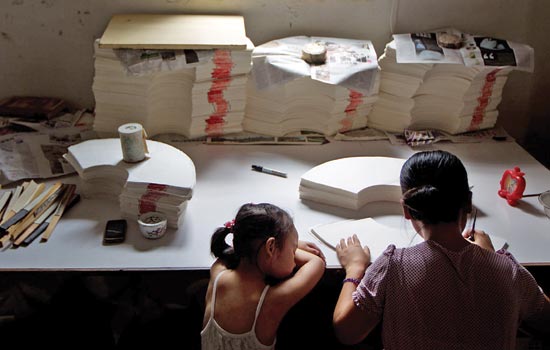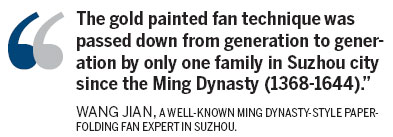Wood fans maintains an ancient tradition
By Xie Yu in Suzhou, Jiangsu (China Daily) Updated: 2012-07-30 10:01Some people are exploring other ways for the development of this ancient industry. On Xibei (literally northwest) Street, where Sun's company is located, several fan shops are in business under the name of "studio".
Wang Jian, a 49-year-old Suzhou native, is the most successful of them. His two-room workshop is well decorated with traditional Chinese furniture, tea sets, potted orchids and, most importantly, his work.
|
 |
|
A woman painting a paper folding fan at a Suzhou-based small workshop while her daughter sleeps beside her. A paper folding fan in the Ming Dynasty (1368-1644) style can cost as much as tens of thousands of yuan with customers mainly from China and Japan. [Photo/China Daily] |
As a most notable figure in current China's fan making circle, Wang is an expert of making paper-folding fans in the Ming Dynasty (1368-1644) style. People offer tens of thousands of yuan to get a fan made by him, but few get their wishes granted.
"I do not make many fans now. I am more interested in repairing old fans. If they are good ones, I do not charge a penny to repair them," he said.
As an avid fan maker, Wang's biggest wish is to continue the techniques and tastes of Ming Dynasty fans. He said by admiring and repairing ancient fans, he better understands the skills of the ancient masters. More importantly, he feels the "smell" of the ancient fans.
Fan making can be traced back 2,000 years. Wang believes it reached its peak between 1368 and 1644, when the framework was at its most delicate, the painting and calligraphy were the most elegant and the functions and shapes were the most diversified, he said.
"It is impossible to reach that level nowadays but I try my best to get close to it," he said.
The complicated construction process and demanding standards Wang insists upon make it impossible to mass produce.
The bamboos need to be stored for eight years before being used in the framework so that weak or cracked ones can be picked out. The rice paper should be carefully selected and painted with a special paint formula to ensure good permeability of water and high strength. Wang and his apprentice mainly make fans in spring and autumn when, at 20 degrees Celsius, the temperature is optimal.

Because of his ideals and low output, it is impossible to serve ordinary customers. The few he makes each year are mostly to order or snapped up by artists and collectors.
The turnover, however, is not low: A Ming Dynasty-style gold-painted paper-folding fan is worth more than 60,000 yuan.
"The gold painted fan technique was passed down from generation to generation by only one family in Suzhou city since the Ming Dynasty," Wang said, adding he is devoted to keeping the traditional techniques alive.
When he left his former employer, Suzhou Fan Factory, in 2000, Wang did not expect his own business would thrive. The factory relocated due to lack of orders. As a fan maker who started to learn the craft when he was 18, Wang knows little except how to make fans.
"Making fans is the only thing that I am capable of and interested in. And I want to make the real beautiful Chinese fans, not rough ones," he said.
In a society in which industrial production has destroyed almost all handicraft businesses, Wang is evidence it is still possible to preserve some ancient skills while making considerable profits.
"Usually, people believe that only older people like fans. But I can tell you that more and more young people are also interested in this art form," said Jiang Xiaoming, 35, who organizes an informal association of fan collectors in Suzhou.
xieyu@chinadaily.com.cn
- China's express deliveries booming in 2015
- Shares slump to a halt on the first trading day of new year
- Confinement center provides high-end service to new moms
- Caixin China manufacturing PMI edges down in December
- Experts turn attention to technological progress
- Market dives as investors dump shares to avoid volatility
- China's high-tech exports beat Japan and South Korea
- PwC takes China's positives into account

















